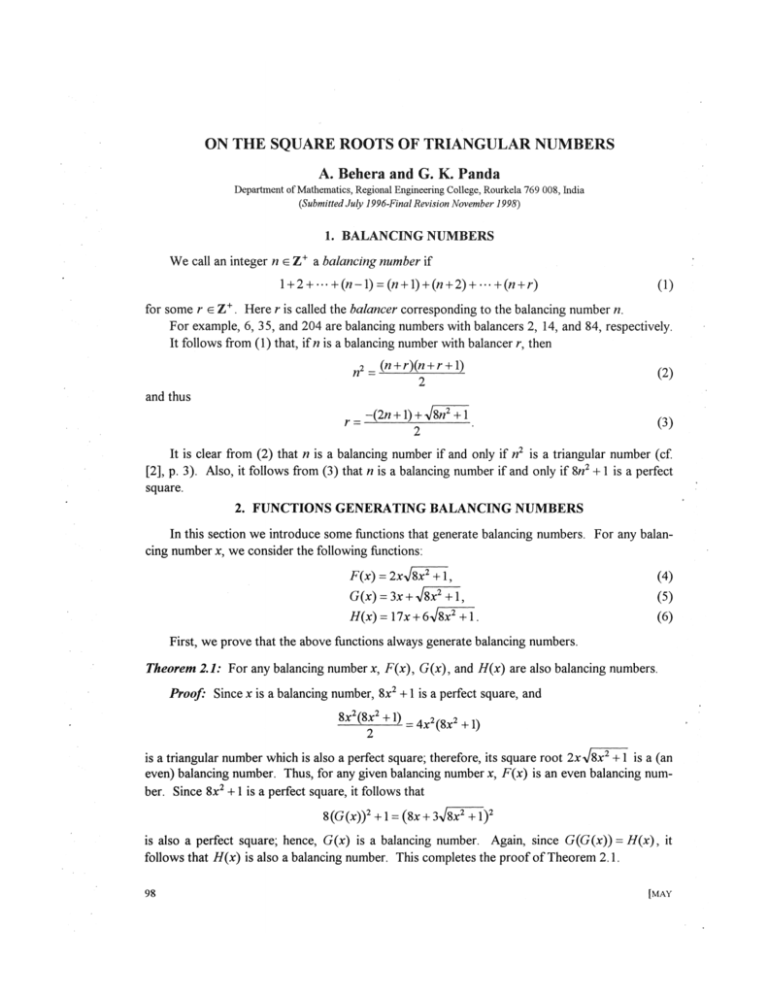ON THE SQUARE ROOTS OF TRIANGULAR NUMBERS A. Behera
advertisement

ON THE SQUARE ROOTS OF TRIANGULAR NUMBERS
A. Behera and G. K. Panda
Department of Mathematics, Regional Engineering College, Rourkela 769 008, India
(Submitted July 1996-Final Revision November 1998)
1. BALANCING NUMBERS
We call an Integer n e Z + a balancing number if
1+ 2+ --- + ( » - l ) = (w + l) + (w + 2) +••• + (» + >•)
(1)
for some r e Z + . Here r is called the balancer corresponding to the balancing number n.
For example, 6, 35, and 204 are balancing numbers with balancers 2, 14, and 84, respectively.
It follows from (1) that, if n is a balancing number with balancer r, then
n2^(n
+ r)(n + r + l)
r=-(2ft
+ l) + V8ft2 + l
2
^
and thus
W
It is clear from (2) that w is a balancing number if and only if n2 is a triangular number (cf
[2], p. 3). Also, it follows from (3) that n is a balancing number if and only if 8n2 +1 is a perfect
square.
2. FUNCTIONS GENERATING BALANCING NUMBERS
In this section we introduce some functions that generate balancing numbers. For any balancing number x, we consider the following functions:
F(x) = 2xV8x2 + l,
G(x) = 3x + V8x2 + 1,
H{x) = \lx + 6V8x 2 +l.
(4)
(5)
(6)
First, we prove that the above functions always generate balancing numbers.
Theorem 2.1: For any balancing number x, F(x), G(x), and H(x) are also balancing numbers.
Proof: Since x is a balancing number, 8x2 +1 is a perfect square, and
8x2(8x2 + l ) ^ 4 x 2 ( 8 x 2
+ 1)
is a triangular number which is also a perfect square; therefore, its square root 2x V8x2 +1 is a (an
even) balancing number. Thus, for any given balancing number x, F(x) is an even balancing number. Since 8x2 +1 is a perfect square, it follows that
8(G(x))2 +1 = (8x + 3V8x2 + l) 2
is also a perfect square; hence, G(x) is a balancing number. Again, since G(G(x)) = H(x), it
follows that i/(x) is also a balancing number. This completes the proof of Theorem 2.1.
98
[MAY
ON THE SQUARE ROOTS OF TRIANGULAR NUMBERS
It is important to note that, if x is any balancing number, then F(x) is always even, whereas
G(x) is even when x is odd and G(x) is odd when x is even. Thus, if x is any balancing number,
then G(F(x)) is an odd balancing number. But
G(F(x)) = 6xV8x2 + l + \6x2 +1.
The above discussion proves the following result.
Theorem 2.2: If x is any balancing number, then
K(x) = 6xV8x2 + l +16x2 +1
(7)
is an odd balancing number.
3, FINDING THE NEXT BALANCING NUMBER
In the previous section, we showed that F(x) generates only even balancing numbers,
whereas K(x) generates only odd balancing numbers. But H(x) and K(x) generate both even
and odd balancing numbers. Since H(6) = 204 and there is a balancing number 35 between 6 and
204, it is clear that H(x) does not generate the next balancing number for any given balancing
number x. Now the question arises: "Does G(x) generate the next balancing number for any
given balancing number x?!! The answer to this question is affirmative. More precisely, if x is
any balancing number, then the next balancing number is 3x + V8x2 +1 and, consequently, the
previous one is 3x - V8x2 4-1.
Theorem 3.1: If x is any balancing number, then there is no balancing number y such that
x < y < 3x + V8x2 + 1 .
Proof: The function G: [0, oo) -> [1, oo), defined by G(x) = 3x + V8x2 +1, is strictly increasing since
G'(x) = 3 + , 8 *
>Q.
Also, it is clear that G is bijective and x < G(x) for all x > 0. Thus, G~l exists and is also strictly
increasing with G~l(x) < x. Let u = G_1(x). Then G(u) = x and u = 3x + v8x 2 +1. Since u < x,
we have u = 3x - V8x2 4-1. Also, since 8(G_1(x))2 +1 = (8x - 3V8x2 +1) 2 is a perfect square, it
follows that G_1(x) is also a balancing number.
Now we can complete the proof in two ways. The first is by the method of induction', the
second is by the method of infinite descent used by Fermat ([2], p. 228).
By induction: We define BQ = l (the reason is that 8 -1 2 +1 = 9 is a perfect square) and Bn =
G(Bn_x) for n = 1,2,.... Thus, Bl = 6, B2 = 35, and so on. Let ZZJ be the hypothesis that there is
no balancing number between Bt_x and Bt. Clearly, Hx is true. Assume Ht is true for / = 1, 2, ...,
n. We shall prove that Hn+l is true, i.e., there is no balancing number^ such that Bn <y<Bn+v
Assume, to the contrary, that such a j exists. Then G~l(y) is a balancing number, and since G_1
is strictly increasing, it follows that G~l(Bn) <G~l(y) <G~~l(Bn+l), i.e., Bn_x <G~l(y) <Bn, which
is a contradiction to the assumption that Hn is true. So Hn+l is also true. Thus, if x is a balancing
number, then x = Bn for some n and there is no balancing number between x and G(x).
1999]
99
ON THE SQUARE ROOTS OF TRIANGULAR NUMBERS
By the method of infinite descent: Here assume Hn is false for some n. Then there exists a
balancing number y such that Bn_l <y<Bn, and this implies that Bn_2 <G~l(y) <Bn_x. Finally,
this would imply that there exists a balancing number B between B0 and Bx, which is false. Thus,
Hn is true for n = 1,2,....
This completes the proof of Theorem 3.1.
Corollary 3.2: If x is any balancing number, then its previous balancing number is 3x - V8x2 + 1 .
Proof: G(3x-V8x 2 + l) = x.
4, ANOTHER FUNCTION GENERATING BALANCING NUMBERS
In this section we develop a function f(x,y) of two variables generating balancing numbers
such that all the functions F(x), G(x), H(x), and K(x) are obtained as particular cases of this
function.
Let x be any balancing number. We try tofindbalancing numbers of the form
B- px + q^Sx2 + 1,
where p, q e Z + . In the previous section we have seen that most of the balancing numbers are of
this form. Since B is a balancing number, SB2 +1 = (8#x + pjsx2 +1) 2 + 8#2 - p2 +1 must be a
perfect square; this happens if Sq2-p2 + 1 = 0, i.e., p = JSq2 +1. Since p e Z + , it follows that
$q2 +1 must be a perfect square, and this is possible if q is a balancing number.
The above discussion proves the following theorem.
Theorem 4.1: If x andj are balancing numbers, then
f(x, y) = xftf + l +WS*2 + 1
(8)
is also a balancing number.
Remark 4.2: (a) fix, x) = F(x); (b) f(x, 1) = G(x); (c) f(x, 6) = H(x); (d) f(x, G(x)) = K(x).
5. RECURRENCE RELATIONS FOR BALANCING NUMBERS
We know that Bx-6, B2 - 35, B3 = 204, and so on. We have already assumed that B0 - 1.
In Section 3 we proved that, if Bn is the n* balancing number, then
Bn+1 = 3B„ + y[$BjTl
and
Bn_x = W„ - ^
+1.
It is clear that the balancing numbers obey the following recurrence relation:
Bn^ = 6Bn-Bn_v
(9)
Using the recurrence relation (9), we can obtain some other interesting relations concerning
balancing numbers.
Theorem 5.1:
(a) B„^Bn_^{B„
B
B
+ \){B„-l).
0>) n = k- n-k ~ k-\ • Bn-k-i
100
B
B
for aiw
positive integer k < n.
[MAY
ON THE SQUARE ROOTS OF TRIANGULAR NUMBERS
B2n=B2n-B2n_v
(c)
(d)
B
2n+l =
B
n(Bn+l-Bn-l)-
Proof: From (9), it follows that
Bn+l +
B
Bn_l=6
n
Replacing n by n - 1 in (10), we get
B
„-i + Bn-2=6
(11)
B
n-l
From (10) and (11), we obtain B% - Bn_x- Bn+l = B%_t- Bn_2° Bn. Now, iterating recursively, we
see that B%-Bn_vBn+l = B?-B0B2 = 36-l-35 = l. Thus, B2n -1 = Bn+l • Bn_h from which (a)
follows.
The proof of (b) is based on induction. Clearly, (b) is true for n > 1 and k = 1. Assume that
(b) is true for k = r, i. e., Bn = Br- Bn_r - Br_x • Bn_r_v Thus,
5 r + 1 • £„_,._! - 5 r • Bn_r_2 = (65 r - 4-_1)5„_r_1 - 5 r • 5w_r_2
= 6Br • 5 ^ ^ ! - 5 r - l ' 4i-r-l ~ ^r ' Bn-r-2
= Br(6Bn-r-l ~ Bn-r-2) ~ Br-\ ' Bn-r-\
= Br • Bn_r - Br_x • Bn_r_x = £„,
showing that (b) is true for k = r +1. This completes the proof of (b).
The proof of (c) follows by replacing n by In and & by n in (b). Similarly, the proof of (d)
follows by replacing n by In +1 and A by n in (b). This completes the proof of Theorem 5.1.
6. GENERATING FUNCTION FOR BALANCING NUMBERS
In Section 5 we obtained some recurrence relations for the sequence of balancing numbers.
In this section our aim is to find a nonrecursive form for Bni n - 0,1,2,..., using the generating
function for the sequence Bn.
Recall that the generating function for a sequence {xn} of real numbers is defined by
n=0
Thus,
1 dn
, .
(see [5], p. 29).
5=0
Theorem 6.1: The generating function of the sequence Bn of balancing numbers is g(s) =
and, consequently,
1-6^2
Mi?
A:=0
V
where [ ] denotes the greatest integer function.
1999]
101
ON THE SQUARE ROOTS OF TRIANGULAR NUMBERS
Proof: From (9) for n = 1,2,..., we have Bn+l - 6Bn + Bn_x = 0. Multiplying each term by sn
and taking summation over n = 1 to n = oo, we obtain
jix^* - ef;^+^z^-^-1=o
which, in terms of g(s), yields
l(g(s) -l-6s)-
6(g(s) -1) +sg(S) = 0.
Thus,
g(s)
6 W
L _ - = (1 - (6s - s2))'1
1-65 + 52 V V
"
= l + ( 6 ^ - ^ ) + (6^-^ 2 ) 2 + (65-5 2 ) 3 + .-..
=
(13)
When n is even, the terms containing sn in (13) are (6s-s2)"'2, (6s-.s 2 ) ( ' l/2)+1 , ...,(6s~s2)n,
in this case the coefficient of sn in #(.$) is
When 7i is odd, the terms containing sn in (13) are (6s - s2)^'2,
in this case the coefficient of sn in g(s) is
and
(6^-^) ( w + 3 ) / 2 ,..., (6s-s2)", and
6
" -f W r 1 ) 6 "" 2 + P*2 2 ) 6 "" 4 - - +(-l)(w"1)/2[ J J6.
(15)
It is clear that (14) represents the right-hand side of (12) when n is even and (15) represents the
right-hand side of (12) when n is odd. This completes the proof of Theorem 6.1.
1. ANOTHER NONRECURSIVE FORM FOR BALANCING NUMBERS
In Section 6 we obtained a nonrecursive form for Bn, n = 0,1,2,..., using the generating
function. In this section we shall obtain another nonrecursive form for Bn by solving the recurrence relation (9) as a difference equation.
We rewrite (9) in the form
B^-6Bn+B^
= 0,
(16)
which is a second-order linear homogeneous difference equation whose auxiliary equation is
A2-6A + l = 0.
(17)
The roots XY = 3 + -J$ and A2 = 3 - V8 of (17) are real and unequal. Thus,
Bn = Arl+Br2,
(is)
where A and B are determined from the values of B0 and Bx. Substituting B0 = l and Bl = 6 into
(18), we get
A +B = \
(19)
AAt + BA2 = 6.
(20)
102
[MAY
ON THE SQUARE ROOTS OF TRIANGULAR NUMBERS
Solving (19) and (20) for A and B, we obtain
A-
^2~^ =
• B= ^ ~ ^ 1 -
^*
^2
Substituting these values into (18), we get
Ji,= ;
? , "=o,i,2,....
Theorem 7.1: If Bn is the 72th balancing number, then
B„ = A\
7
, " = 0,1,2,...,
where Ax = 3 + V$ and 2 2 = 3 - V8 .
8. LIMIT OF THE RATIO OF THE SUCCESSIVE TERMS
The Fibonacci numbers ([1], p. 6) are defined as follows: F0 = 1,Fx = 1, Fn -Fn_l+Fn_2 for
n = 2,3,.... It is well known that
Fn+l 1 + ^5
r
M-»OO r
A
which is called the golden ratio [1]. We prove a similar result concerning balancing numbers.
Theorem 8.1: If Bn is the /1th balancing number, then
l i m % ^ 3 + V8.
«->>oo Bn
Proof: From the recurrence relation (9), we have
%
L
+% I - 6 .
(21)
Putting 2 = l i m ^ ^ - in (21), we get A2 - 6X +1 = 0, i.e., X = 3 ± V8. Since 5W+1 > 5„, we must
have A > 1. Thus, A = 3 + V8 . This completes the proof of Theorem 8.1.
An alternative proof of Theorem 8.1 can be obtained by considering the relation
and using the fact that B„ -> oo as n -> oo.
It is important to note that the limit ratio 3 + V8 represents the simple periodic continued
fraction ([4], Ch. X)
[6,-61 = 6 +
6+
—.
,
(22)
- — -6h +—...
6+and from Theorem 178 ([4], p. 147) it follows that, if C„ is the nth convergent of (22), then
1999]
103
ON THE SQUARE ROOTS OF TRIANGULAR NUMBERS
nn+2
nn+2
where XY = 3 + JE and X2 = 3 - V8. An application of Theorem 7.1 shows thatQ = ^±L; thus,
^ = 1 ^ ^ = 5 ^ , 1 1 = 0,1,2,....
9. AN APPLICATION OF BALANCING NUMBERS TO A
DIOPHANTME EQUATION
It is quite well known that the solutions of the Diophantine equation
x2+y2 = z2, x,y,zGZ+
(23)
are of the form
x = u2-v2,
y = 2uv, z = u2+v2,
where % v e Z + and 2/ > v ([3], [4], [7]). The solution (x, j , z) is called a Pythagorean triplet.
We consider the solutions of (23) in a particular case, namely,
x2 + (x + l ) 2 = / .
(24)
In this section we relate the solutions of (24) with balancing numbers.
Let (x, y) be a solution of (24). Hence, 2y2 -1 = (2x +I)2. Thus,
is a triangular number as well as a perfect square. Therefore,
£ =VjW-l)
(25)
is an odd balancing number (since y2 and 2 j 2 - 1 are odd). Since y2 > 1, it follows from (25) that
y2=1±M7i
(26)
Again, since y is positive by assumption, we have
From (24) and (26), we obtain
V = I ^ 1 + V8# 2 +1
'
2
4
Since x is positive, it follows that
^(V8,S 2 + l - l ) - l
X
~
2
For example, if we take 5 = 35 (an odd balancing number), then we have
VKV8-352 + 1-Q-1
X= —
= 1
2
104
[MAY
ON THE SQUARE ROOTS OF TRIANGULAR NUMBERS
and
32 + (3 + l) 2 =5 2 ,
i.e.,
x2 + (x + l) 2 = j 2 .
ACKNOWLEDGMENT
It is a pleasure to thank the anonymous referee for valuable comments and suggestions that
greatly improved the presentation of this paper.
REFERENCES
G. E. Andrews. Number Theory. New York: Hindustan Publishing Company, 1992.
L. E. Dickon. History of the Theory of Numbers II: Diophantine Analysis. New York:
Chelsea, 1952.
H. Griffin. Elementary Theory of Numbers. New York: McGraw Book Company, 1954.
G. H. Hardy & E. M. Wright. An Introduction to the Theory of Numbers. London: Oxford
University Press, 1960.
V. Krishnamurthy. Combinatorics, Theory and Application. New Delhi: Affiliated EastWest Press, 1985.
I. Nivan & H. S. Zukerman. An Introduction to the Theory of Numbers. New Delhi: Wiley
Eastern, 1991.
O. Ore. Number Theory and Its History. New York: McGraw Book Company, 1948.
7
AMS Classification Numbers: 11B39, 11D09
• > •!• • >
1999]
105







